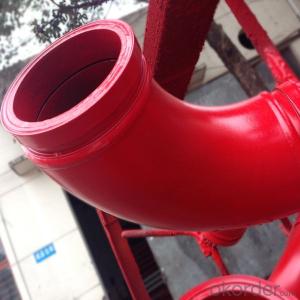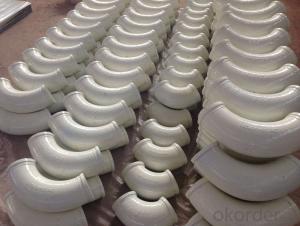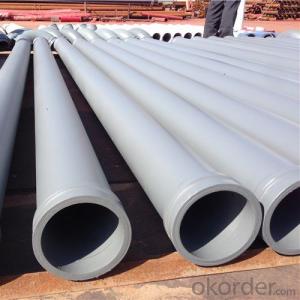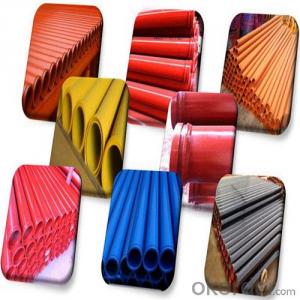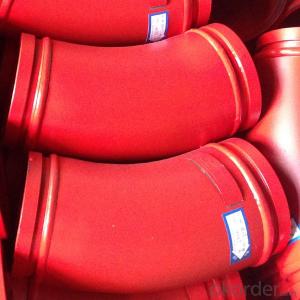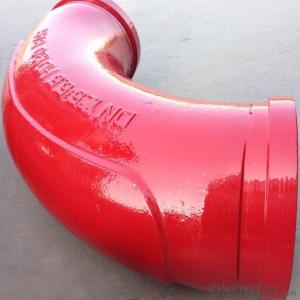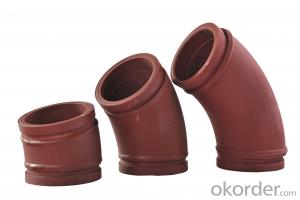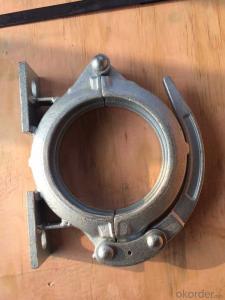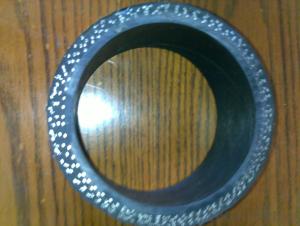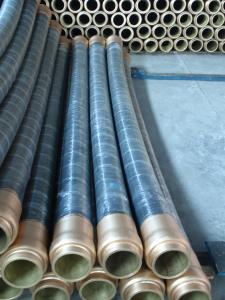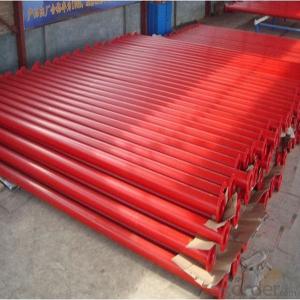Concrete Pumps Spare Parts Elbow Double Wall 90DEG R275
- Loading Port:
- Tianjin
- Payment Terms:
- TT OR LC
- Min Order Qty:
- 100 pc
- Supply Capability:
- 1000 pc/month
OKorder Service Pledge
OKorder Financial Service
You Might Also Like
Product Description:
The Concrete Pumps Spare Parts Elbow 90DEG R275 Double Wall normally made by special MN13-4, to make sure the quanlity of elbows according to customer’s requests we usually keep the content of MN strictly over 15%, it will have a longer life as well, package will be in plywood box or cartons and put into container.
Scope of Application of the Goods
The Concrete Pumps Spare Parts Elbow 90DEG R275 Double Wall is a concrete pumps parts for combined use with other concrete parts in for concrete pumps and truck pumps. It can be widely used in the construction of various types of concrete structures like industrial and civil buildings, bridges, roads, and other types of infrastructure.
This seals can only be used in Schwing type concrete pumps and truck pumps as well, but not in any other operations.
Product Advantages:
OKorder's Concrete Pumps Spare Parts Elbow 90DEG R275 Double Wall Channels are durable, strong, and safety.
Main Product Features:
· Premium quality
· Prompt delivery & seaworthy packing (5-10 days)
Reliable performance
Easy to weld
High safety.
· Professional Service
· Competitive pricing
Measuring of wall thickness from the outside
Low purchase cost
Specifications:
Elbow 90DEG R275 Double Wall Layers
Capacity Life: 80,000 cbm
FAQ:
Q1: How long about delivery time Concrete Pumps Spare Parts Elbow 90DEG R275 Double Wall ?
A1: Normally we keep the raw materials for old customers and sometime we also keep stock products to make sure delivery time in any emergency cases.
Q2: How do we guarantee the quality of our Concrete Pumps Spare Parts Elbow 90DEG R275 Double Wall?
A2: We have established an advanced quality management system which conducts strict quality tests at every step, from raw materials to the final product. At the same time, we provide extensive follow-up service assurances as required.
Q3: How soon can we receive the product after purchase?
A3: Within three days of placing an order, we will book the vessel for goods. The specific shipping date is dependent upon international and government factors, but is typically 7 to 30 workdays.
Q4: If we can produce some goods according to customers request?
A4: Yes, we can produce Elbow 90DEG R275 Double Wall according to the difference country situations to make it suitable to the market and customers. We have very professional technical team to make the design for porduction of seals.
Q5: How to make a quick resolution for after service?
A5: OKorder and our manufacture both have overseas branches all-around of world.
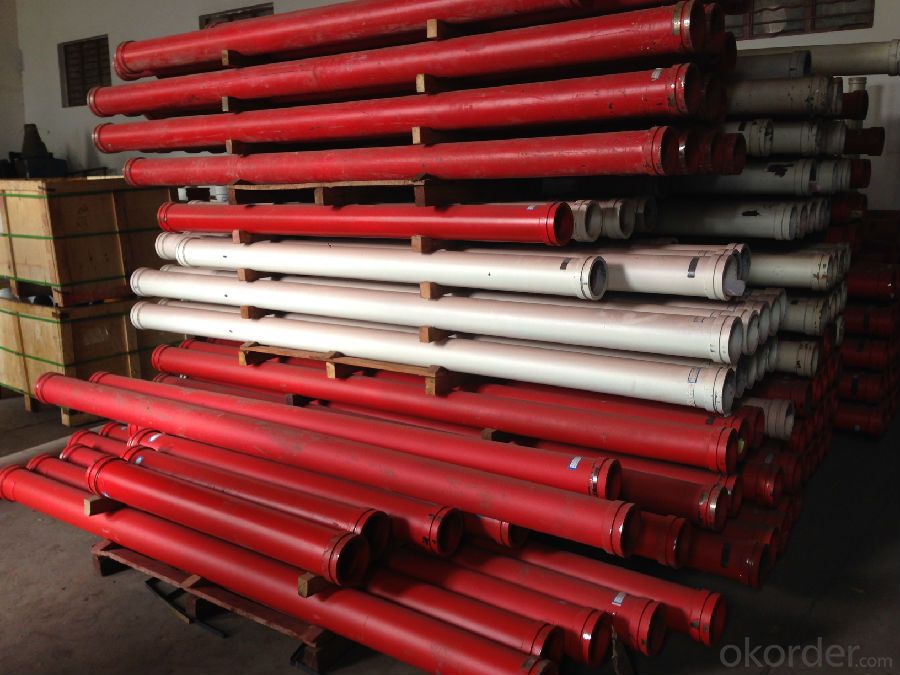

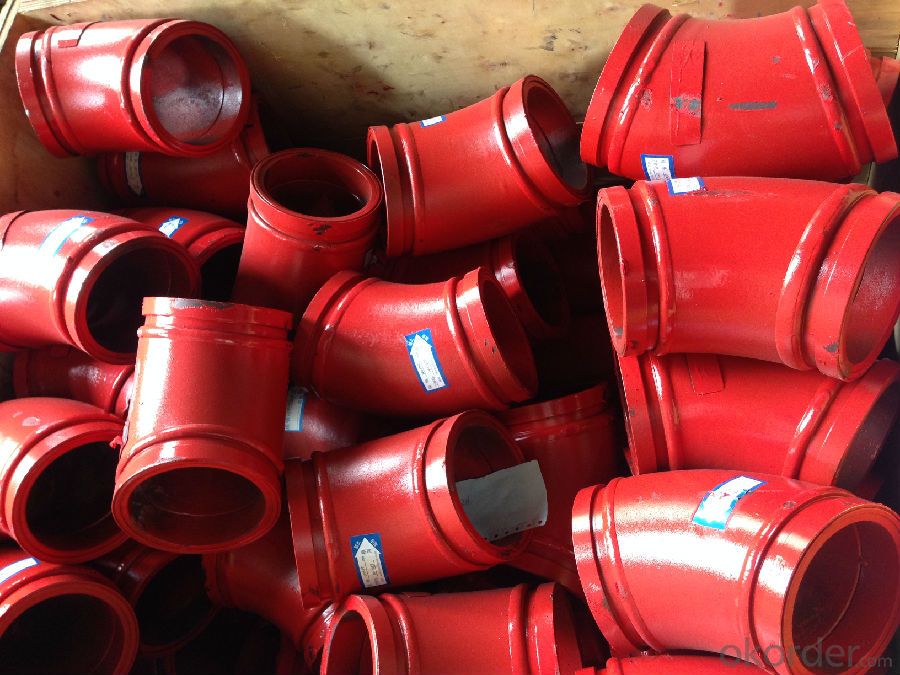
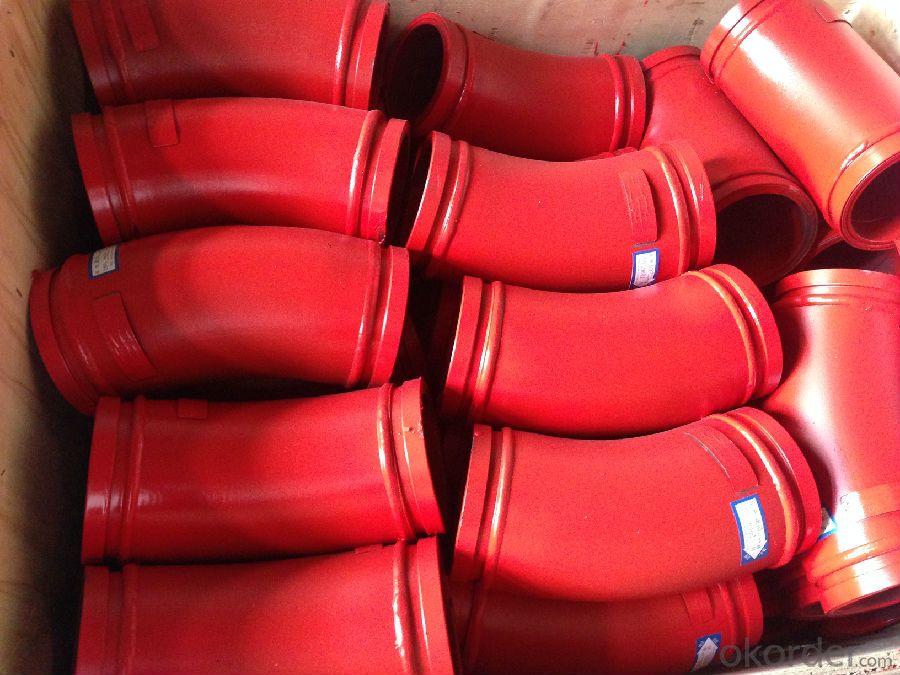
- Q: What are the different types of concrete pump wear rings?
- There are several different types of concrete pump wear rings that are commonly used in the construction industry. The most common types include: 1. Metallic Wear Rings: These wear rings are typically made of hardened steel or stainless steel. They are highly durable and can withstand the abrasive nature of concrete. Metallic wear rings are designed to be long-lasting and provide excellent wear resistance. 2. Polyurethane Wear Rings: Polyurethane wear rings are made from a high-performance polymer material. They are known for their exceptional resistance to abrasion, impact, and chemical exposure. Polyurethane wear rings are often preferred for their flexibility and ability to provide a tight seal, reducing leakage and improving pump performance. 3. Ceramic Wear Rings: Ceramic wear rings are made from a high-density ceramic material, such as alumina or zirconia. They are extremely hard and have excellent resistance to wear and corrosion. Ceramic wear rings are commonly used in high-pressure applications where there is a need for superior durability and performance. 4. Composite Wear Rings: Composite wear rings are made by combining different materials, such as metal and polymer, to create a hybrid material. These wear rings offer the advantages of both materials, such as the strength of metal and the flexibility of polymers. Composite wear rings are often used in applications where a balance between durability and flexibility is required. Each type of wear ring has its own unique advantages and considerations. The choice of wear ring depends on various factors, such as the specific application, operating conditions, and budget constraints. It is important to consult with experts or manufacturers to determine the most suitable wear ring for a concrete pump.
- Q: What is the function of a concrete pump hopper agitator shaft bearing?
- The function of a concrete pump hopper agitator shaft bearing is to provide support and facilitate smooth rotation of the agitator shaft, ensuring effective mixing of the concrete in the hopper.
- Q: Are there any specific guidelines for the installation of pistons or cylinders in concrete pump spare parts?
- Installing pistons or cylinders in concrete pump spare parts requires adherence to specific guidelines. These guidelines play a vital role in guaranteeing the equipment's functionality and durability. 1. Thoroughly clean and inspect: Before installation, it is imperative to meticulously clean and inspect the pistons or cylinders to detect any damage or defects. Eliminating any debris or contaminants is essential to avoid potential operational issues. 2. Apply suitable lubrication: To minimize friction and ensure smooth movement, it is necessary to apply an appropriate lubricant to the piston or cylinder. This step also aids in preventing premature wear and tear, thereby extending the parts' lifespan. 3. Ensure proper alignment: Achieving proper alignment between the piston and cylinder is crucial. The piston must be correctly aligned with the cylinder bore to prevent binding or excessive wear. This can be accomplished by following the manufacturer's instructions or seeking professional guidance, if needed. 4. Adhere to torque specifications: Bolts or fasteners must be tightened according to the manufacturer's recommended torque specifications. Over-tightening or under-tightening can result in leaks or mechanical failure. 5. Use adequate sealing materials: To maintain an effective seal between the piston and cylinder, appropriate sealing materials such as gaskets or O-rings must be utilized. This prevents fluid leakage and preserves the equipment's efficiency. 6. Perform thorough testing: After installation, it is advisable to conduct tests to ensure the pistons or cylinders are functioning correctly. This may involve trial runs or pressure testing to identify any leaks or abnormalities. By adhering to these guidelines, the installation of pistons or cylinders in concrete pump spare parts can be executed accurately, resulting in reliable and efficient equipment operation. Referring to the manufacturer's instructions or seeking professional assistance is recommended if any doubts or concerns arise during the installation process.
- Q: How can one determine the correct viscosity and temperature range for lubricants used in concrete pump spare parts?
- Determining the correct viscosity and temperature range for lubricants used in concrete pump spare parts involves considering several factors. Here are some steps to help you determine the appropriate viscosity and temperature range: 1. Consult the manufacturer's guidelines: The first step is to refer to the manufacturer's recommendations or guidelines for the specific concrete pump spare parts. The manufacturer may provide specific viscosity and temperature range requirements for the lubricants used in their equipment. 2. Understand the operating conditions: It is crucial to have a clear understanding of the operating conditions in which the concrete pump spare parts will be used. Factors such as ambient temperature, pump speed, load, and pressure should be considered. These factors can significantly impact the lubricant's viscosity requirements and temperature range. 3. Consider the lubricant's performance characteristics: Different lubricants have varying performance characteristics that make them suitable for specific applications. Look for lubricants that are specifically formulated for heavy-duty applications, provide excellent wear protection, and have good thermal stability. These performance characteristics will ensure that the lubricant can withstand the demanding conditions of a concrete pump. 4. Viscosity requirements: The viscosity of a lubricant is a critical factor in ensuring proper lubrication and protection of the concrete pump spare parts. Higher viscosity lubricants are generally recommended for heavy-duty applications, whereas lower viscosity lubricants are suitable for lighter loads. The viscosity requirements may also vary based on the specific pump parts, such as bearings, gears, or seals. Referring to the manufacturer's guidelines and consulting with lubricant suppliers can help determine the ideal viscosity range for the concrete pump spare parts. 5. Temperature range: The temperature range in which the concrete pump operates is another crucial aspect to consider. Lubricants should be able to maintain their viscosity and performance across the expected temperature range. Extreme temperatures can cause lubricants to lose their effectiveness, leading to equipment damage or failure. Therefore, it is important to select lubricants that have a temperature range suitable for the operating conditions of the concrete pump. 6. Seek expert advice: If you are unsure about the correct viscosity and temperature range, it is always advisable to consult with lubricant manufacturers, suppliers, or industry experts. They can provide valuable insights and recommendations based on their expertise and experience with concrete pump spare parts. By considering the manufacturer's guidelines, understanding the operating conditions, evaluating the lubricant's performance characteristics, and seeking expert advice, you can determine the correct viscosity and temperature range for lubricants used in concrete pump spare parts. This will help ensure optimal lubrication and prolong the lifespan of the equipment.
- Q: What are the signs of a malfunctioning concrete pump outrigger?
- There are multiple indicators that point towards a malfunctioning concrete pump outrigger. 1. An uneven or unstable platform may suggest that the outrigger is not functioning properly. This can be observed when the pump is not level or when the platform exhibits excessive movement or shaking. 2. The presence of hydraulic fluid leaks in the outrigger's hydraulic system is a telltale sign of malfunction. If you notice puddles or stains on the ground caused by hydraulic fluid, it signifies a problem. 3. If the outrigger is slow to extend or retract, or if it does not respond to the controls, it indicates a malfunction. This can jeopardize the stability of the pump and should be taken seriously. 4. Unusual noises emanating from the outrigger, such as grinding, whining, or knocking sounds, can be indicative of mechanical issues or loose components. Ignoring these noises may lead to underlying problems that require attention. 5. It is crucial to visually inspect the outrigger for any visible damage, such as bent or cracked components, loose bolts, or missing parts. These physical signs of damage can impair the functionality and stability of the outrigger. Regular inspection and maintenance of the concrete pump outrigger are essential for ensuring safe and efficient operation. If any of these signs are present, it is advisable to cease using the pump and have it inspected and repaired by a qualified professional to prevent further damage or accidents.
- Q: What are the different types of concrete pump hopper cylinders?
- In the construction industry, there exists a variety of concrete pump hopper cylinders that are commonly utilized. These cylinders possess a vital function in the operation of concrete pumps, as they supply the necessary pressure and force to facilitate the movement of concrete throughout the system. One particular kind of concrete pump hopper cylinder is the single-acting cylinder. This cylinder operates by utilizing hydraulic pressure to extend the piston rod, which subsequently propels the concrete out of the hopper and into the pumping system. Single-acting cylinders are renowned for their simplicity and reliability, thus making them a favored choice for numerous construction projects. Another type of concrete pump hopper cylinder is the double-acting cylinder. As the name implies, this cylinder operates in both directions, enabling a more efficient and powerful pumping process. Double-acting cylinders possess the capability of pushing the concrete out of the hopper during the extension stroke, as well as pulling the piston rod back during the retraction stroke. Consequently, this results in a greater pumping capacity and increased productivity. Furthermore, there is also a range of sizes and capacities available for concrete pump hopper cylinders. These sizes vary, with smaller cylinders suitable for smaller construction projects, and larger cylinders capable of handling heavy-duty pumping operations. The selection of cylinder size relies on factors such as the volume of concrete to be pumped, the distance and height of the pumping location, and the specific requirements of the project. In conclusion, the assortment of concrete pump hopper cylinders encompasses single-acting cylinders and double-acting cylinders. Each type possesses its own advantages and is suitable for different construction applications. The determination of the cylinder's size and capacity should be based on the specific necessities of the project. Ultimately, the selection of the appropriate cylinder type is essential in guaranteeing efficient and effective concrete pumping operations.
- Q: How do I properly maintain and replace hydraulic pumps in concrete pump spare parts?
- Proper maintenance and replacement of hydraulic pumps in concrete pump spare parts involve a few key steps. Firstly, it is crucial to regularly inspect the hydraulic pump for any signs of wear, leaks, or damage. This includes checking the fluid levels, filters, and hoses. Secondly, following the manufacturer's guidelines, ensure that the hydraulic pump is regularly serviced and that the recommended maintenance tasks are performed on schedule. This includes changing the hydraulic fluid, replacing filters, and lubricating moving parts. Lastly, when it comes to replacing hydraulic pumps, it is important to use genuine and compatible spare parts that are recommended by the manufacturer. Additionally, it is advisable to seek professional assistance or consult the manufacturer's instructions to ensure proper installation and alignment of the new pump.
- Q: Are there any specific safety precautions while replacing concrete pump spare parts?
- There exists a variety of safety precautions that must be followed when replacing concrete pump spare parts. 1. Personal Protective Equipment (PPE) is of utmost importance and should be worn to safeguard against potential hazards. This includes safety goggles, gloves, a helmet, and steel-toed boots. 2. It is essential to adhere to proper lockout/tagout procedures prior to replacing any spare parts. This entails disconnecting and securing the power source to prevent accidental startup of the pump. 3. Before commencing the replacement process, inspect all tools and equipment for any indications of damage or defects. It is crucial to refrain from using faulty equipment, as it can pose significant safety risks. 4. When handling heavy spare parts, it is imperative to employ appropriate lifting techniques to prevent strain or injury. Ensure that proper assistance and equipment, such as cranes or forklifts, are available if necessary. 5. Maintain a clean and well-organized work area to prevent trips, slips, and falls. Remove any obstacles or debris that may jeopardize safety during the replacement process. 6. Only trained and authorized personnel should be involved in the replacement of concrete pump spare parts. They must possess a thorough understanding of the equipment and procedures to minimize the likelihood of accidents. 7. Always consult the manufacturer's guidelines and instructions when replacing spare parts. This will ensure that the process is executed safely and accurately. 8. It is vital to have a plan in place for potential emergencies, including fires or injuries. Make certain that fire extinguishers and first aid kits are easily accessible, and that all workers are familiar with their locations and usage. By adhering to these safety precautions, the risk of accidents, injuries, and damage can be significantly reduced when replacing concrete pump spare parts.
- Q: How is the piping of the concrete pipe designed?
- Concrete transmission pipe, according to the project and construction site characteristics, concrete pouring plan piping. Should shorten the length of the pipeline, less elbow and hose. The laying of the transmission pipe shall ensure safe construction, easy cleaning of the pipeline, troubleshooting and installation and maintenance
- Q: What is the role of a concrete pump hopper vibrator?
- The role of a concrete pump hopper vibrator is to ensure the smooth and efficient flow of concrete from the hopper into the pump. It helps to prevent clogging and blockages by vibrating the hopper, which loosens the concrete and allows it to flow freely into the pump.
Send your message to us
Concrete Pumps Spare Parts Elbow Double Wall 90DEG R275
- Loading Port:
- Tianjin
- Payment Terms:
- TT OR LC
- Min Order Qty:
- 100 pc
- Supply Capability:
- 1000 pc/month
OKorder Service Pledge
OKorder Financial Service
Similar products
Hot products
Hot Searches
Related keywords
